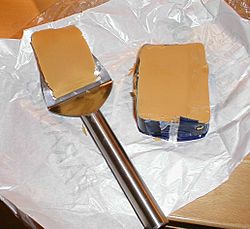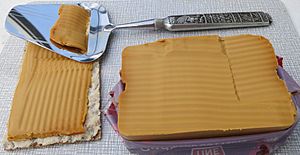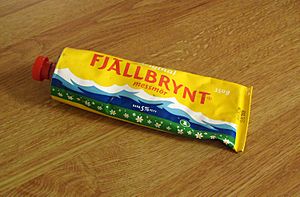Brunost facts for kids

Brunost is usually sliced very thinly using a metal cheese slicer
|
|
| Alternative names |
|
|---|---|
| Type | Whey cheese |
| Place of origin | Norway |
| Main ingredients | Whey, milk and/or cream |
| Variations |
|
| 66kcl kcal | |
| Other information | Typically served as a sandwich, crispbread, or biscuit topping, or in sauces |
Brunost (pronounced "BROO-nohst") means "brown cheese" in Norwegian. It's a special type of food that looks and tastes like cheese. It's also called mysost ("whey cheese").
Brunost is made from whey, milk, and sometimes cream. The most popular kind is called Gudbrandsdalsost. Brunost is mostly made in Norway. It's a very important part of Norwegian food and culture. People in South Korea also enjoy it.
Contents
History of Brunost: A Sweet Discovery
People in Scandinavia have been boiling down whey for a very long time. They made a brown, cheesy spread called prim or messmör. This tradition goes back at least 2,500 years! In 2016, scientists even found cheese residue from around 650 B.C.E. on old pottery in Jutland. This might have been an early form of brunost.
Anne Hov's Big Idea
The modern, firm brunost we know today was created by a milkmaid named Anne Hov. This happened in 1863 in the Gudbrandsdalen valley in Norway. At that time, farmers in Gudbrandsdalen were struggling. They weren't making much money from selling grain and butter.
Anne Hov had a clever idea. While working on a farm, she tried adding cream to the whey when boiling it. She boiled it for a long time in an iron pot. This made a firmer, fattier, and more cheese-like product. She first called it feitost ("fat cheese"). Later, its name changed to fløtemysost ("cream whey cheese").
Brunost Helps the Valley
Anne's new product quickly became popular in the area. When she moved to a new farm, she started making even more. She also added goat's milk to the mix. This gave the cheese an even stronger taste.
A local trader named Ole Kongsli loved it. He thought people in Oslo, the capital city, would also like it. He started selling it there as Gudbrandsdalsost. It was a huge success! This new cheese helped the Gudbrandsdalen region a lot. It brought money and helped the area recover from its economic problems.
In 1933, when Anne Hov was 87, she received the King's Medal of Merit. This was a special award for her important contributions to Norwegian food and economy.
Brunost Today
Today, the biggest producer of brunost is a Norwegian dairy company called Tine. They make 13 different kinds! Another company, Synnøve Finden, also makes brunost. There are also many smaller, local producers.
What is Brunost? Description and Taste
Brunost is part of a family of foods called mysost. These are made from whey and milk or cream. Whey is what's left over after cheese is made from milk. So, technically, brunost isn't a "true" cheese. But it's made by cheese makers and used just like cheese. So, most people think of it as a cheese!
Texture and Flavor
Brunost has a firm texture. It's a bit softer than cheeses like Gouda. It's easy to slice and doesn't crumble.
The taste of brunost is sweet. Many people describe it as tasting like caramel. If it has goat's milk, it also has a slightly tangy flavor. The kind called Ekte Geitost ("true goat's cheese") is made only with whey and goat's milk. It has a very strong, goat cheese-like taste that balances the sweetness.
How Brunost is Made
Making brunost involves boiling a mix of milk, cream, and whey. This boiling goes on for several hours. As the water evaporates, the milk sugars turn into caramel. This is what gives brunost its special brown color and sweet taste. Once it's packed and cooled, it's ready to eat! If you want a lower-fat brunost, makers use more whey and less milk and cream.
Different Kinds of Brunost
In Norway, brunost is usually put into two main groups. One group uses only cow's milk and cream. The other group includes some goat's milk. The ones with goat's milk are often called Geitost or Gjetost ("goat's cheese"). If a brunost has only goat's milk, it's called Ekte Geitost ("true goat's cheese").
Popular Varieties
The most popular kind of brunost is Gudbrandsdalsost. It's made with a mix of cow and goat milk, cream, and whey. In Norway, people often just say "Brunost" or "Geitost" when they mean Gudbrandsdalsost. It's also the most popular kind outside of Norway.
The second most popular is Fløtemysost. This one has a milder taste because it doesn't have goat's milk. Ekte geitost is the third most popular.
Related Foods
There are other foods similar to brunost:
- Prim (Norwegian) or messmör (Swedish) is a soft, sweet spread. It's made by boiling whey for a shorter time. It doesn't have added milk or cream.
- Requeijão moreno from Brazil is very similar to cow's milk brunost. It's made by boiling cow's milk until it turns brown and caramelizes.
How People Enjoy Brunost
Brunost is most often eaten on sandwiches, crispbread, or biscuits. It's a common part of the traditional Norwegian matpakke. A matpakke is a packed lunch that Norwegians often take to work or school. Even if brunost gets warm, its taste stays the same, which is great for packed lunches.
People also love brunost on Norwegian waffles. It's also used in cooking, especially in sauces for game meats like deer or elk.
Brunost and Your Health
People in Norway sometimes discuss how healthy brunost is. It has good things like calcium, proteins, and vitamin B. It also has Iodine. Unlike many other cheeses, it doesn't have salt.
Iron and Sugar
Long ago, brunost was made in iron pots. This meant it had a lot of iron. When modern factories started using aluminum pots, the government worried people wouldn't get enough iron. So, they ordered iron to be added to the cheese! Today, modern brunost doesn't have much iron.
Brunost does have a good amount of natural sugar and fat. Because of this, some people say it's a bit like milk chocolate. But many types of brunost actually have less fat than other popular cheeses.
The Famous "Goat Cheese Fire"
In January 2013, something unusual happened in Norway. A lorry carrying 27 tons of brunost caught fire inside a tunnel. The cheese burned so hot that firefighters couldn't get close for four days! The fats and sugars in the cheese kept the fire going.
The tunnel was badly damaged and closed for months. This event was called "the goat cheese fire" by news outlets around the world.
See also
 In Spanish: Geitost para niños
In Spanish: Geitost para niños



